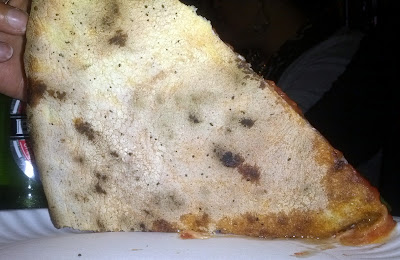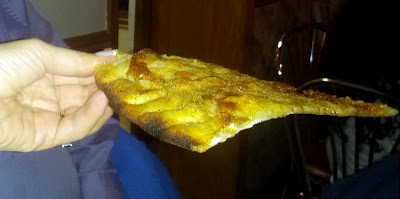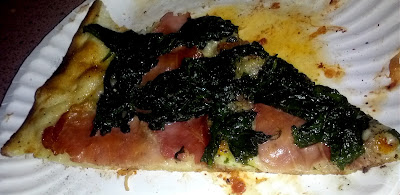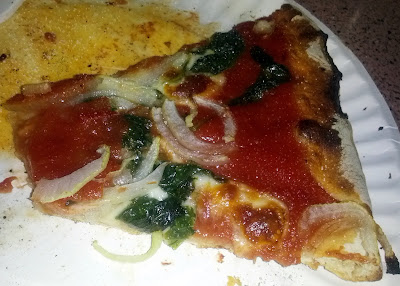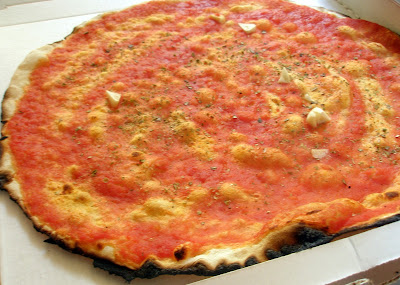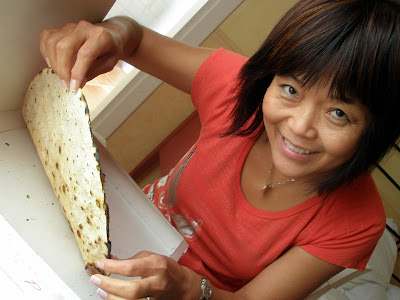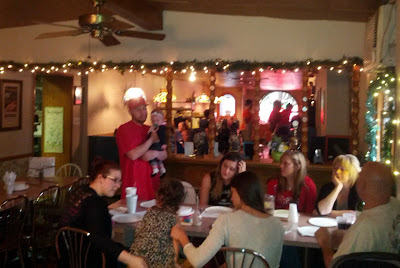A Request for Neapolitan Pizza Makers
I’ve been eating pizza – in the American Northeast, between Philly and New York – for decades before the very welcome explosion of talented chefs who can replicate Neapolitan pizzas (Naples style, the birthplace of pizza). I am grateful that now, in probably every major American city, there is a place to get excellent Neapolitan pizza. However, I do have mixed feelings.
 |
| The brilliant Neapolitan pizza at Motorino |
For years before the widespread introduction of authentic Neapolitan style pizza in America, plenty of pie makers mis-labeled their pies. Some said “New York style” and others claimed “Neapolitan” simply by the addition of a basil leaf (or less!), but that was generally a sign of a sloppy pizza with a soft floppy crust, neither thin nor thick, with too much cheese. Perhaps some definitions are in order.
Commodity Pie
Most pizza sold in America is commodity-style. Of course, lots of it is pre-fab stuff from the big chains like Pizza Hut, Domino’s, and Papa John’s (my take on Papa John's HERE). But most mom-n-pop shops are selling commodity pizza, too. The chains have forced them to compete on price, so they use mass-sourced ingredients (like Sysco) and make pizzas that are forgettable. Typically soft crusts, undercooked, and overloaded with toppings to convey a sense of value. Most of it is not better than supermarket frozen pizza.
 |
| Floppy, sloppy, commodity pizza |
There are plenty of distinct, often regional, styles of pizza, and you can learn about them at Slice – Serious Eats (LINK HERE).
Neapolitan Pie
Neapolitan pizzas are smaller, made to serve one. They are typically not sliced – you are served the whole disc. The crust is a thing of beauty – thin base, puffy edges, leopard spotting all over the cornicione, and good char underneath. A proper Neapolitan pizza cooks at 800 or 900 degrees, in as little as two or three minutes. The best-known Neapolitan pie is the Margherita, which uses sauce (not chunks or crushed tomatoes) from San Marzano tomatoes, fresh bufalo mozzarella (the milky white, wet cheese), and a handful of fresh basil leaves, often added post-bake.
| Neapolitan pie from Massimo's, Trenton NJ |
I love the Neapolitan pie. LOVE it. I’ve had brilliant ones in Boca Raton and Philly, Phoenix and DC, Trenton and Brooklyn. But even the best ones are typically marred by a wet and sloppy center. The amount of moisture in the cheese and sauce is too much for the short bake time and thin delicate crust. The wet cheese never browns and bubbles, and the center of the pie is soggy. “But Neapolitan is SUPPOSED to be wet in the center, troglodyte!” Yeah, I know that. But wet bread is never a good thing. Never. Well, maybe saltines crumbled into Campbell’s tomato soup.
Trenton - Brooklyn - New Haven Pie
The regional style I know best is the Trenton tomato pie. It is a round pizza, with a thin crust cooked to a delicate crispness while maintaining some chewy interior. Different pie makers vary on the ratios of sauce to cheese; my favorites use canned crushed tomatoes and relatively smaller amounts of cheese. A Trenton pie is never wet, and there is little tip sag. There are char spots on the bottom and cornicione. All the ingredients are in harmony, and nothing is sliding off. You never need a knife and fork to eat it.
 |
| New Haven pie at Frank Pepe's |
Now, folks in Brooklyn and Harlem and New Haven don’t call their pie “Trenton style” but those pizzas all have a lot in common. Patsy’s in East Harlem, Totonno’s (review HERE) in Coney Island, and Pepe’s in New Haven (review HERE) all make a pizza with a thin sturdy crust, and they use restraint with toppings. When I made my list of “58 Pizzas Worth the Calories,” (link HERE) not one Neapolitan pie cracked the Top Ten. Yet who would argue with the excellence of Forcella, Motorino, Osteria, or Nomad?
How to Leverage the Skills of Neapolitan Pie Slingers
This is when I dream of what COULD be.
My first instinct would be to finish a Neapolitan pie under the broiler, but still, the water from the sauce and the cheese has already soaked the crust. You’d get some nice top browning (instead of floating blobs of wet cheese) but you’d still have a soggy crust. The pizzaiolo could reduce the amount of sauce and cheese in the center, at the risk of burning the pie without that moisture to protect it at 900 degrees. But really, I can’t even make a decent pie crust at home without making the kitchen look like it snowed; who am I to tell Neapolitan pizzaioli how to make their pies?
 |
| Hybrid carbonara pizza at La Porta (Media, PA) |
INSTEAD, then, my wish is that they could take use pizza talents to crafting consummate Trenton/Brooklyn/New Haven style pies. Make a pie with a substantial (but thin) crust; find a way to keep all that flavor and leopard spotting from the Neapolitan pie, and incorporate that into a pizza that is crisp on the bottom, sturdy enough to support the toppings, and never wet in the center.
Already, there are some of these hybrid pies out there. La Porta (reviewed HERE), right in my back yard in the Philly Main Line, is number six on my list. On my first visit there, I noted "The crust was an absolute delight with some characteristics of a Neapolitan crust, but firm and crisp like a Trenton/Brooklyn slice. That crust was magical. Everything that topped that crust was a premiere ingredient, applied judiciously, and all in harmony."
 |
| A slice from DeLorenzo's, my #1 Trenton pie |
So I'm wishing that the talented folks who have perfected Neapolitan pies will turn that skill to the kind of pizza that Americans ate before the chains moved in. Nearly all of the best "traditional" pie makers were in business long before there was a Pizza Hut in every town. DiFara, DeLorenzo's, Denino's, Santarpio's, Frank Pepe, Patsy's.
American Pie - Let's Name it and Cherish It
I'd argue that, in America, the Trenton style pie (Brooklyn style, New Haven style, call it what you prefer) is more important, culturally, than our imitation of wet pies from Naples. Neapolitan is great pizza, but it's not the pizza of our fathers, mothers, grandmothers, and grandfathers (exception: my grandfather, born in Naples, used to tell stories of corner street vendors selling pizza before he came to America in 1907).
 |
| A return to the classics at Aanthony's Coal-Fired Pizza (Wayne, PA) |
Classic American Pie is even more important because it's a shrinking supply. While the best ones have become institutions, most have been pushed out by the chains. There is one nice counter-trend -- Anthony's Coal-Fired (reviewed HERE) is a mini-chain with some awfully good pizza that has more in common with Patsy's and Totonno's than it does with the big chains.
What do you say, Neapolitan pizzaioli? Can you expand your menu to revive an American classic?




























































































